

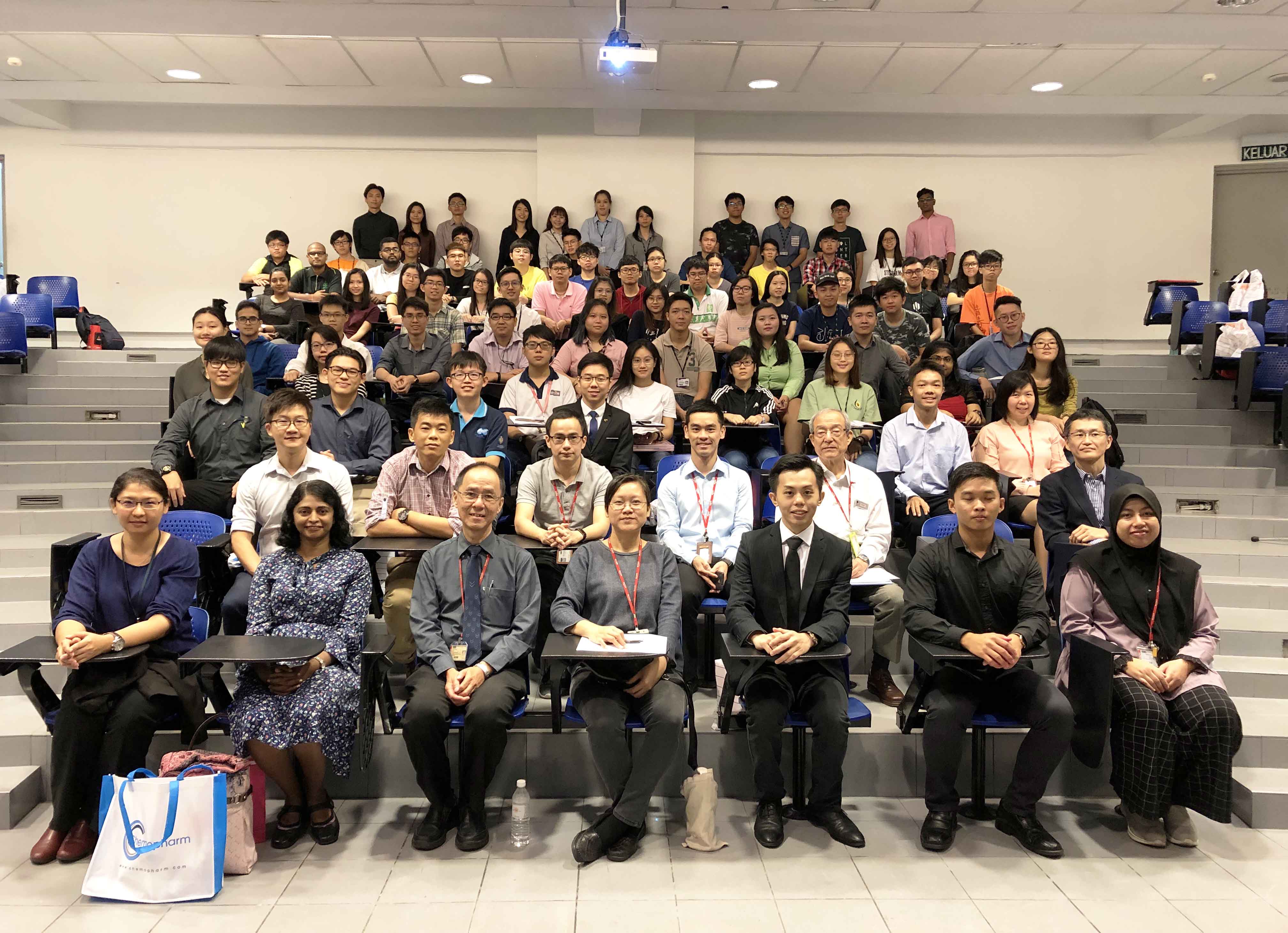
Front row from left: Dr Phoon, Dr Sukganah, Dr Yap, Dr Lo, and Wai Keat with participants at the colloquium
The “FSc and FEGT Postgraduate Colloquium 2019”, a first-ever joint faculty event between Faculty of Science (FSc) and Faculty of Engineering and Green Technology (FEGT) was successfully organised from 26 to 27 January 2019 at UTAR Kampar Campus.
Present at the opening ceremony were FEGT Dean Assoc Prof Dr Yap Vooi Voon, FEGT Deputy Dean for R&D and Postgraduate Programmes Dr Lo Po Kim, FSc Deputy Dean for R&D and Postgraduate Programmes Dr Phoon Lee Quen, Organising Chairperson Toh Wai Keat, staff and participants.
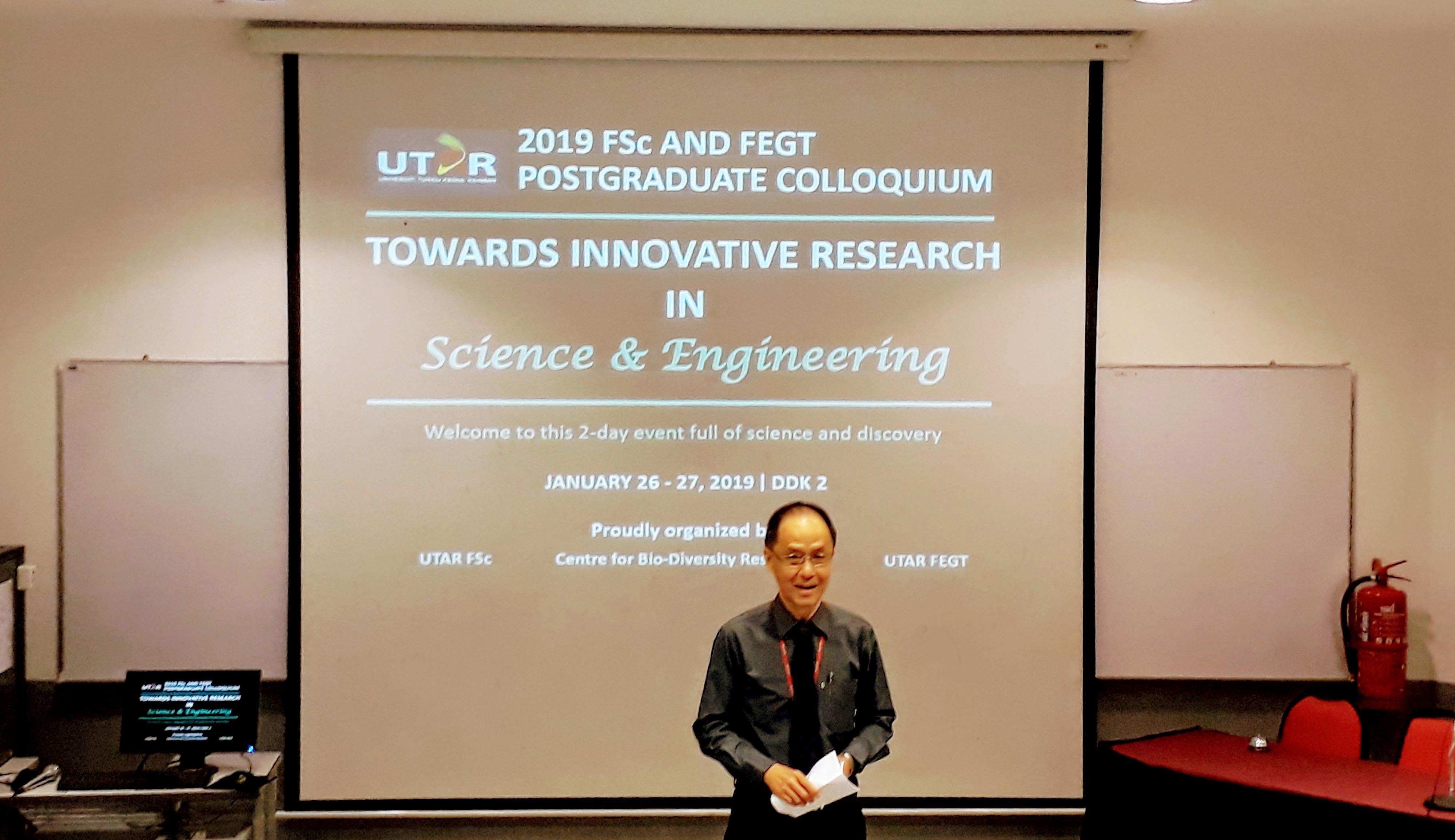
Dr Yap delivering his opening speech
“Let me begin by firstly welcoming and thanking everyone for coming and for supporting this event. This is our first joint faculty event with the FSc and it is really exciting to be able to share research ideas and findings across faculties. The theme of this colloquium is ‘Toward Innovative Research in Science and Engineering’. Innovative research does not necessarily have to high-tech nor high cost. Citing from research done by Stanford, the researchers used only the natural ability of the land to filter water. I consider that as innovative research and solution. I hope with this colloquium, we can be inspired and motivated to generate innovative solutions that will help, benefit and positively impact the society,” said Dr Yap in his opening speech.
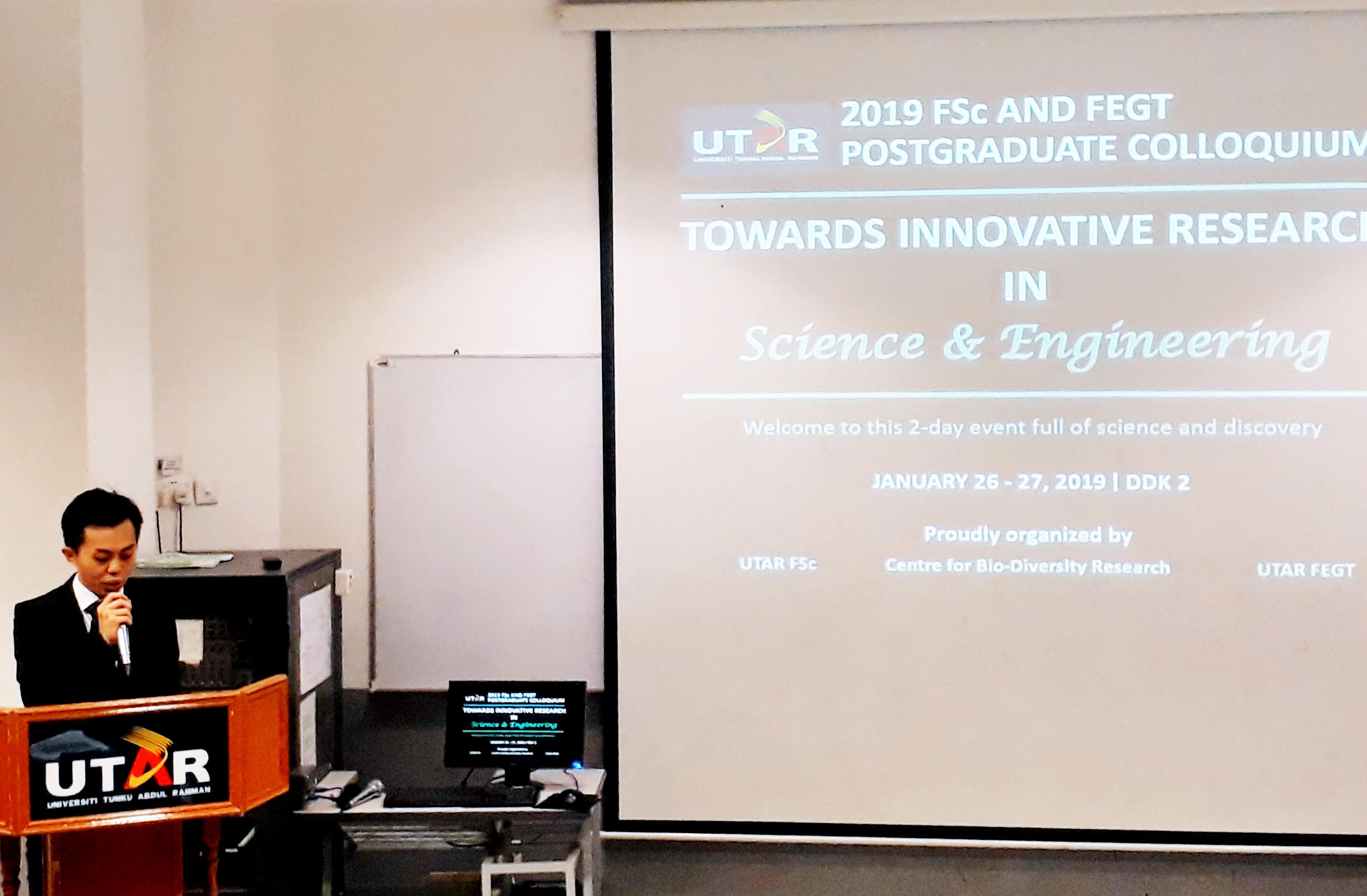
Wai Keat giving his speech
“With the theme ‘Toward Innovative Research in Science and Engineering’, this colloquium aims to promote quality research in recent developments ranging from the fields of life sciences to engineering and green technology. The colloquium is also a platform for postgraduate students of both faculties to exchange their latest findings in formulating and creating novel scientific developments. We are also very honoured to have academics from UTAR’s Faculty of Medicine and Health Sciences, and from Universiti Teknologi Petronas (UTP) to share with us their findings and knowledge. I hope the experience from this colloquium will serve as a motivation to further spur interest in science and engineering research,” said Wai Keat.
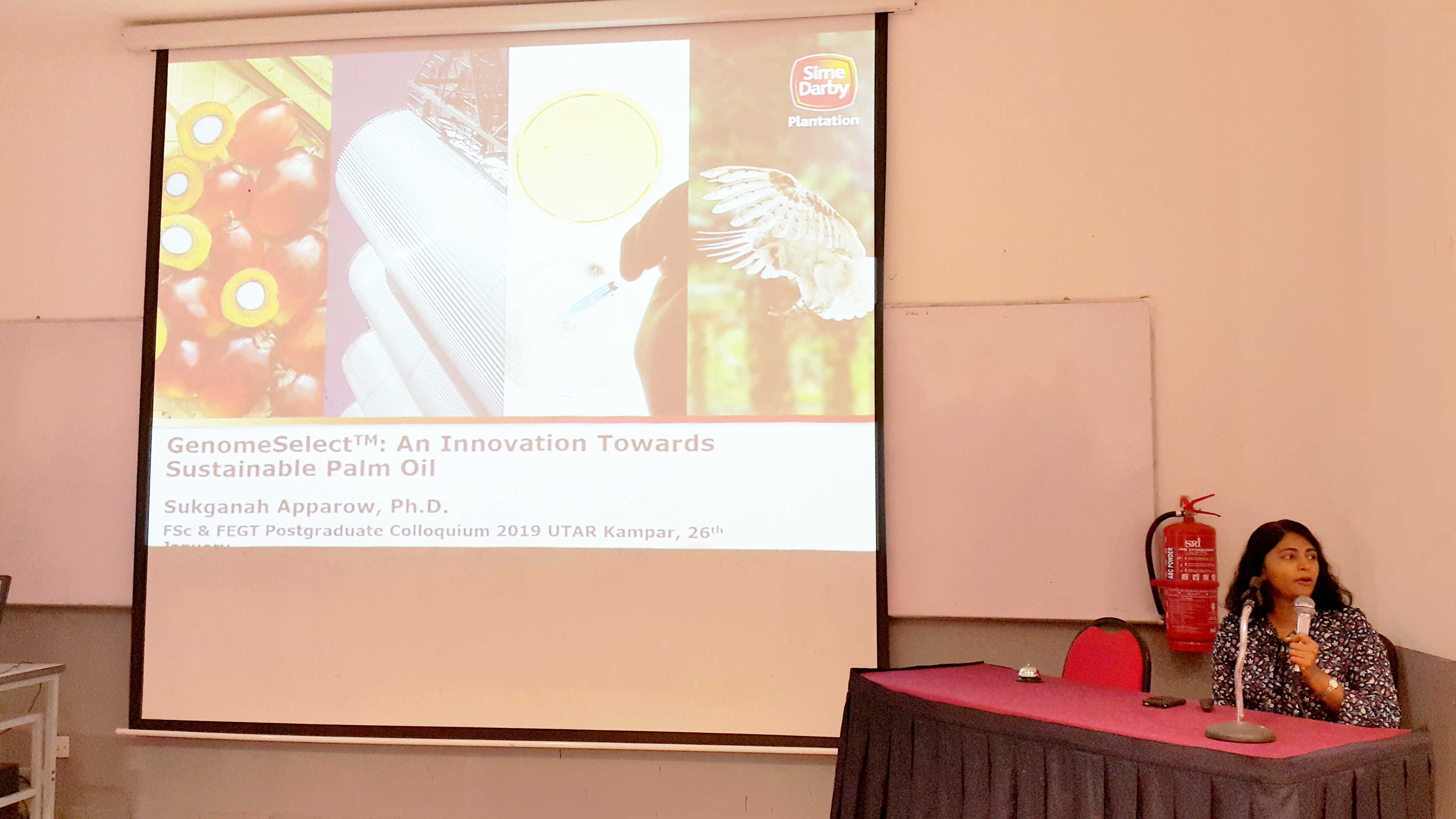
Dr Sukganah giving an introduction about her research
The first to present was keynote speaker Manager of Molecular Breeding Laboratory, Sime Darby Technology Centre Sdn Bhd Dr Sukganah Apparow. With the research, titled “GenomeselectTM: An Innovation Towards Sustainable Palm Oil”, she shared that Sime Darby Plantation, through its R&D wing, has made a concerted effort to increase oil palm yield without further expansion of land area, in order to meet the world’s growing food demand, while keeping the aspiration of Delivering Sustainable Futures. She explained that as the world’s largest producer of certified sustainable palm oil, Sime Darby Plantation has an utmost focus in realising the potential of its oil palm materials through development of genetic models for direct selection and in silico breeding.
“In 2016, 100 ha of high-yielding of GenomeSelectTM oil palms were planted, involving the genotyping of 80,000 seedlings and 80 million genetic tests were conducted over a period of 10 months in order to select the best 18,000 for planting. We have established mass sampling techniques capable of collecting 40,000 fresh lead samples and high-throughput SNP genotyping platforms with the potential to generate 5 million data points on a monthly basis. In-house bioinformatics tools and database have been developed for Big Data analysis and mobile device technologies synchronised to the internal database allows hassle-free selection of the high-yielding palms in the field. The in-house molecular marker deployment technologies have also allowed a reliable quality control system to be established to facilitate selection of parental palms based on genetic breeding values and to ensure correct parentage of the commercial tenera planting materials,” explained Dr Sukganah.
She further elucidated that Sime Darby Plantation has planted another 1,000 ha in 2018, and will reach full replanting capacity in Malaysia using GenomeSelectTM materials by the year 2023. Sample tracking and quality control measure integrated throughout this pipeline from sampling to field selection that ensured the success of the GenomeSelectTM planting will be discussed along with their implementation challenges.
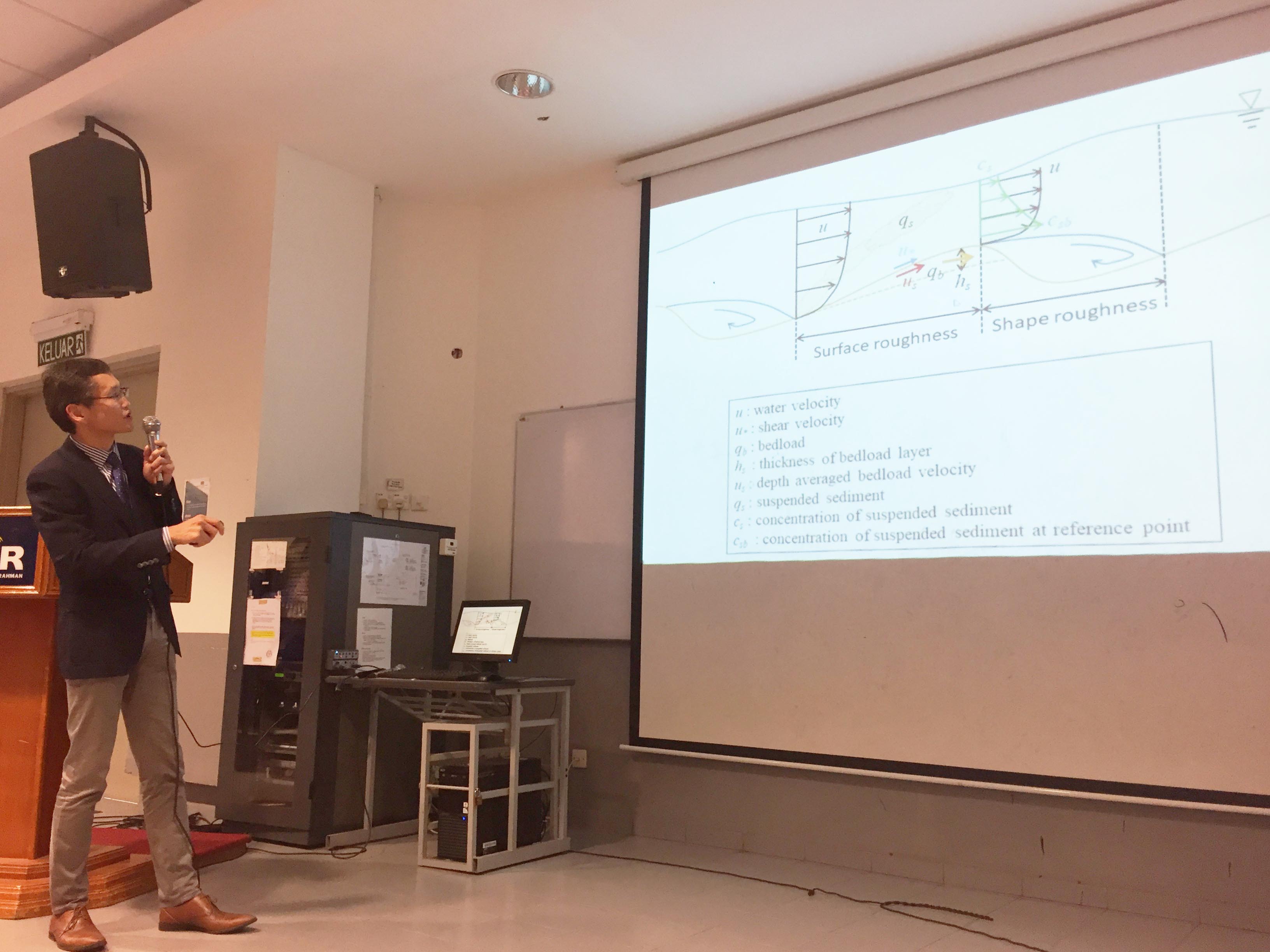
Dr Yorozuya presenting findings from his research
The second keynote speaker was Senior Researcher from Public Works Research Institute (PWRI), Japan Assoc Prof Dr Atsuhiro Yorozuya, who introduced the methodology and the results of the case of Brahmaputra River, in relation to understanding the phenomena of the scale of river depth and river width. Dr Yorozuya mentioned that one of the major disasters is relating sediment, e.g volcano, landslide, debris flow, flood, bank erosion, coastal erosion and others. He clarified that the location of the occurrence in each event is not the same, though they certainly connect each other through the river via sediment transportation. He explained that during the sediment transport process, several different events involve underneath the water surface, such as water flow, the shape of the river bed, and the sediment transport rate, and with the current acoustic technology, it is has become possible to measure this king in actual river even during flooding.
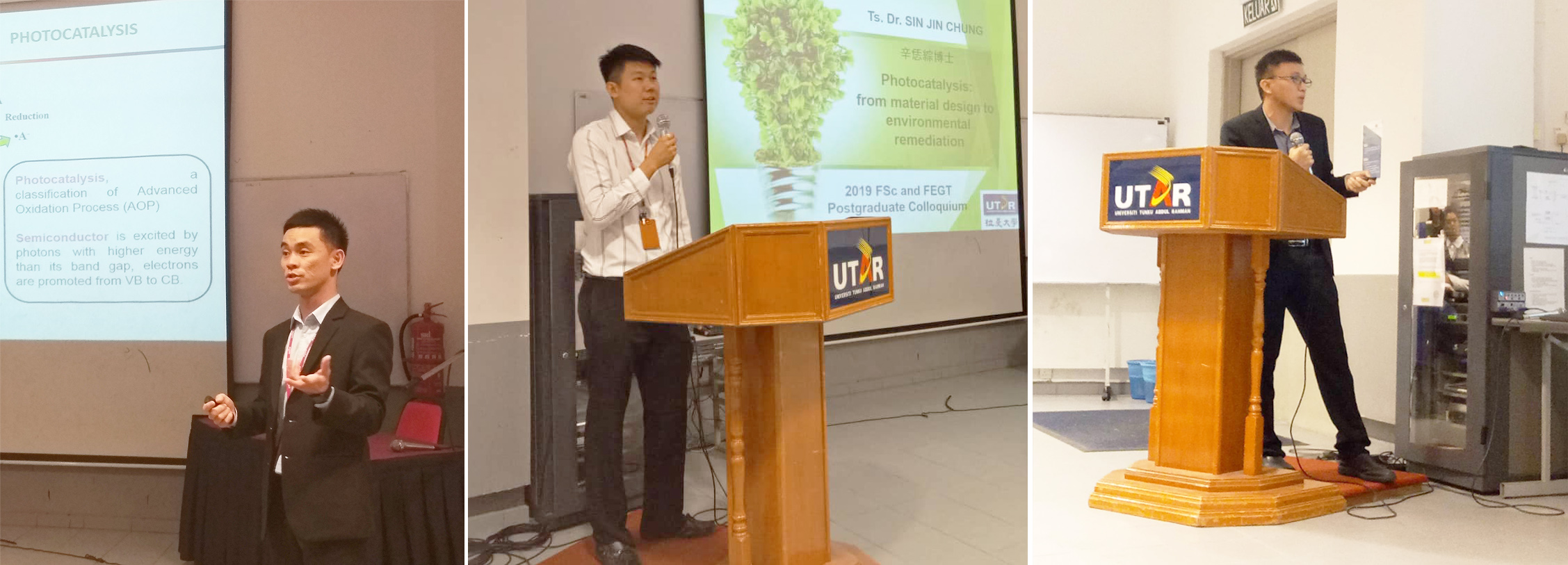
From left: Dr Leong, Dr Sin, and Dr Tan Ji presenting their research
Three invited speakers from UTAR also presented their researches. FEGT lecturer Dr Leong Kah Hon, presented his research titled “Development of Modified Titania Nano Photocatalysts to Enhance Visible Light Absorption”. His research focuses on the development of modified titania nano photocatalysts to synergise and enhance visible light photocatalysis that niched for the destruction of lethal aquatic pollutants. His research explained that in preliminary phase template TiO2 was successfully synthesised through a facile non-hydrolytic sol-gel technique. The material’s chemistry revealed the pristine anatase phase and crystallinity of TiO2. It also demonstrated the influence of crystallinity over photocatalysis efficiency. His study also expressed the variation of these noble metal loading and its influence on the photocatalysis irradiated under artificial visible light. The photocatalysis evaluation studies were performed with lethal and endocrine disrupting compounds (EDCs) of different classification. Dr Leong’s research also clarified the promotion of electron mobility and prolongation of the lifetime of the charged carriers. This was well correlated with photocatalysis evaluation achieved through both good and poor photosensitising pollutants, namely Methylene Blue (MB), Reactive Blue 19 (RB19) and Bisphenol A (BPA). Hence, the present study progressively presented the calibre of the synergisation of conventional photocatalyst to upbeat the limitations and developed a new category of composite photocatalyst. The synthesised photocatalysts well proved their candidature as an active, visible light photocatalyst and laid a sustainable pathway for environmental clean-up as demanded by the planet.
FSc lecturer Dr Tan Ji presented his research titled “Application of molecular methods in Resolving Issues of the Seaweed Industry in Malaysia”. His study demonstrates the employment of molecular methods in elucidating the taxonomy of Kappaphycus and Eucheuma, which in turn offers a means for seaweed farmers to identify and cultivate mono-species of Kappaphycus or Eucheuma. This also led to the development of DNA barcodes for Kappaphycus and Eucheuma which were used in the identification of new species, as well as the selection of potential cultivars for mass propagation or breeding programmes in Southeast Asia. He also explained that the cultivation of red seaweeds is an important means of livelihood for the coastal communities surrounding the Coral Triangle. Among the seaweeds most extensively farmed are Kappaphycus Doty and Eucheuma J. Agardh which produce kappa- and iota- carrageenan, respectively. These polysaccharides are highly valued by the food and cosmetic industry thanks to their varying degree of gelling, thickening and emulsifying properties. As such, Kappaphycusand Eucheuma seaweeds have to be separated prior to processing at the factory to ensure optimal yields and cost-effectiveness. However, the accurate identification of species was typically hindered due to the extensabsortive range of morphotypes, the lack of distinct morphological characteristics as well as the confusing use of colloquial and commercial names.
With his research titled “Photocatalysis: From Material Design to Environmental Remediation”, FEGT lecturer Ts Dr Sin Jin Chung, explained that environmental pollution caused by organic pollutants has become major problems for human society and has seriously threatened the existence of terrestrial lives. The light-driven semiconductor-mediated photocatalysis which can decompose organic pollutants into nontoxic molecules is regarded as one of the most promising ways for the removal of polluted wastewater. Zinc oxide (ZnO), due to its exceptional properties, is widely used as significant photocatalytic material, With the UV light present in natural sunlight, ZnO, photocatalytically degraded and eliminated various organic pollutants in water. The ZnO/Nb2O5 composites enhanced the UV photocatalytic efficiency. The rare earth-doped ZnO absorbed visible light and photocatalytically degraded the organic pollutants. Magnetic separable ZnO/Fe3O4 composites photocatalytically degraded the organic pollutants and inactivated bacteria under visible light effectively. The modified ZnO reduced the photogenerated charge carriers leading to a large number of reactive oxygen species involved in the photocatalytic process. Finally, the ternary oxide semiconductor of BiOBr is of great research interest for its excellent performance as a visible light-driven photocatalyst for degradation of organic pollutants.
“This colloquium is a very good platform for postgraduate students to participate and to share research information with other researchers. It can be difficult to attend conferences or events of such, so being able to participate also paves way for potential research collaboration. It is also an open space for people to understand the progress of certain research and what areas that would interest them or further motivate the researchers,” commented Universiti Teknologi Petronas (UTP) Masters in Civil and Environmental Engineering student Lim Boon Chin.
“I received recommendation from my lecturers to participate and because I myself is also new to this research field, I needed more input from different industries and research work so that I can obtain valuable references. Specifically, on the methodology, I have learnt the various ways other researchers used and how it was conducted. It was enlightening to know how they assess their work,” enthused Chok Jing Chern, who was also one of the oral presenters from UTP.
Another oral presenter and friend of Chok was Chua Siong Chin, who said, “Attending this colloquium is as a good exposure to the different research cultures done in the many institutions. While presenting my research, apart from enabling the public to know more about my research, I also received valuable feedback and comments on how to improve my research.”
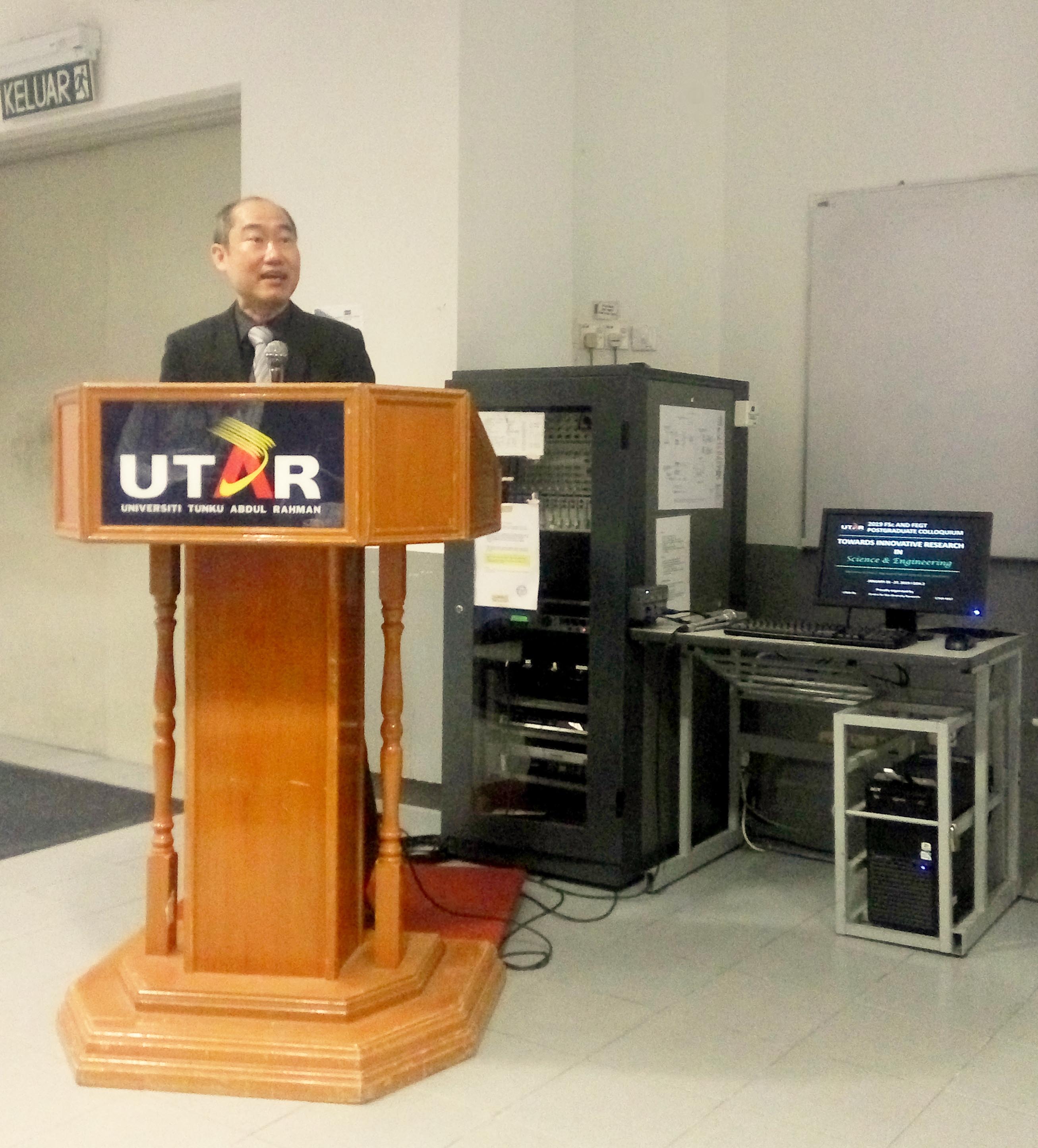
Dr Lim delivering his closing speech
FSc Dean Assoc Prof Dr Lim Tuck Meng marked the close for the colloquium with his closing speech. He said, “It is a very good effort from staff and students of both faculties to work together for a common goal. We share a long history together and it is great to be able to join efforts to organise this colloquium. To the participants, I thank you for your participation. Your participation in this colloquium, is a good way to obtain valuable feedback, comments and discussions that are important to your research. Some comments and feedback may come from different perspectives but it will enable you to view your research from another angle and to restudy your methods, and hence improving your research. I also thank all the sponsors for making this event possible.”
Four best oral presenters were also selected and awarded at the colloquium. The winners were:
Ong Hing Huat
Investigation of Upper Respiratory Carriage of Bacterial Pathogens and Their Circulating Genotypes and Antibiotic Susceptibility Profile in the Kampar District, Malaysia
Quek Jian Ai
Fabrication of Natural Plant Extracts Mediated ZnO Nanoms Terials for Sustainable Visible Light Driven Photocatalytic Antibacterial and Antioxidant Activities
Toh Si Jing
Predicting Movie Box Office: A Machine Learning Approach
Toh Wai Keat
Engineering and Characterisation of Novel Superfolder Green Fluorescent Protein Variants for Use as Plant Reporter Genes
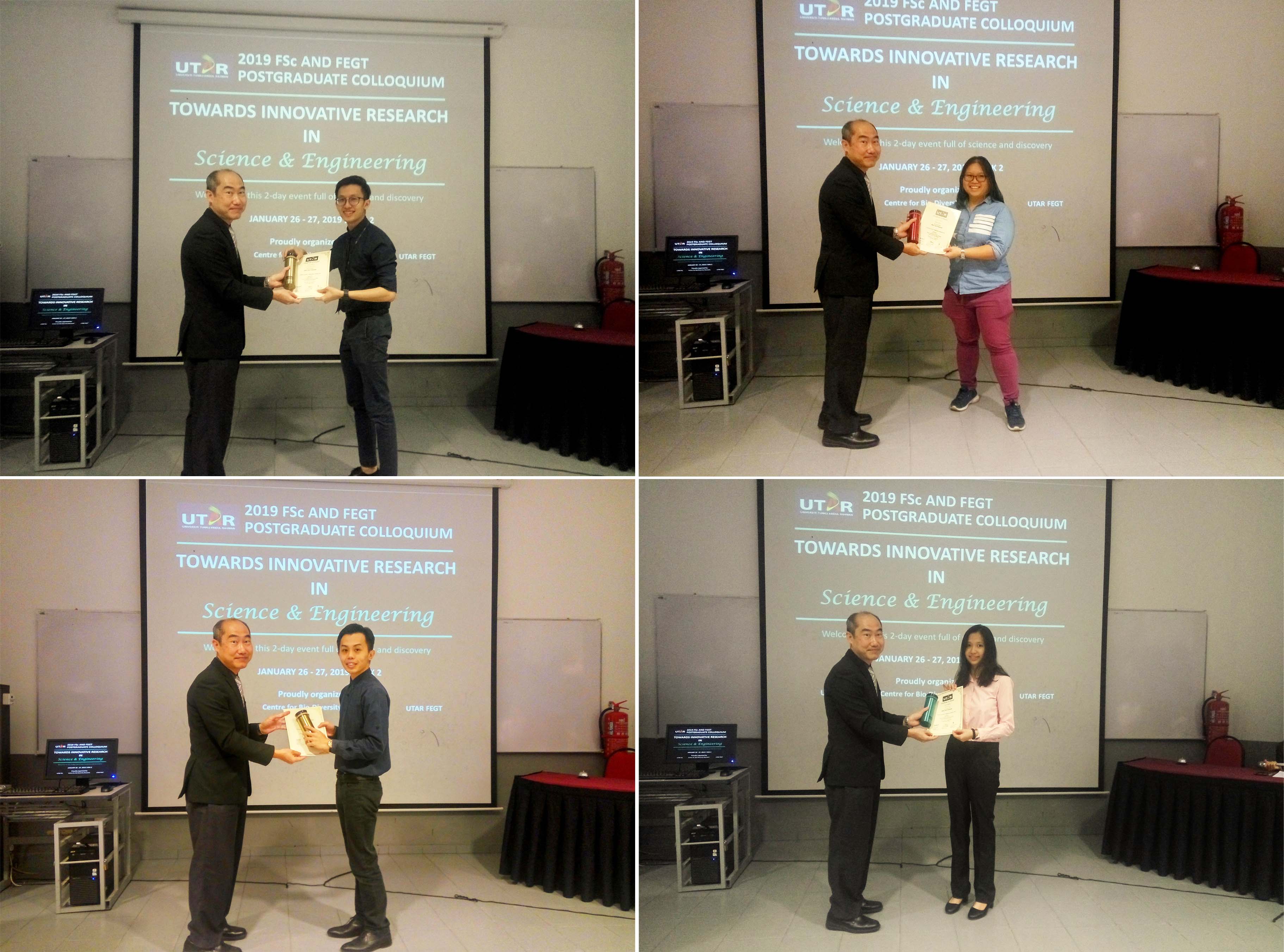
Clockwise from top left: Ong, Quek, Wai Keat and Si Jing receiving their awards for “Best Presenters”
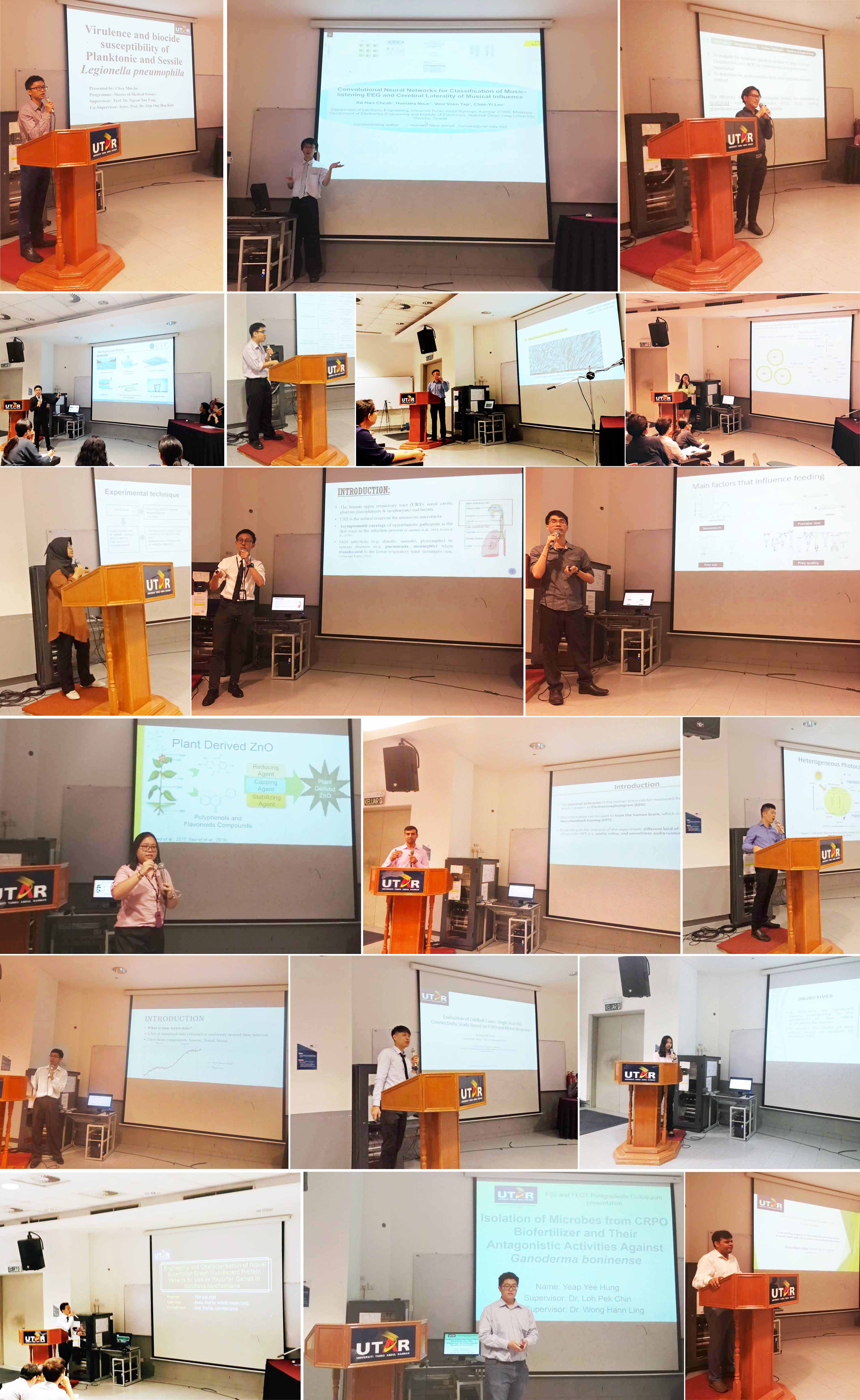
Presenters at the colloquium
For the full abstracts of all 21 oral presenters, click here.
© 2019 UNIVERSITI TUNKU ABDUL RAHMAN DU012(A).
Wholly owned by UTAR Education Foundation Co. No. 578227-M LEGAL STATEMENT TERM OF USAGE PRIVACY NOTICE